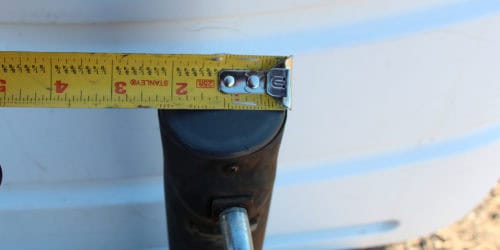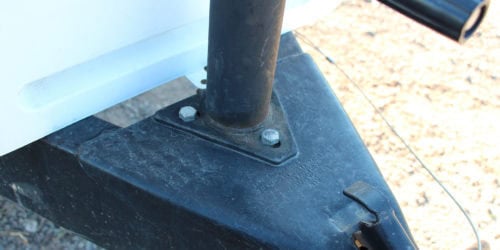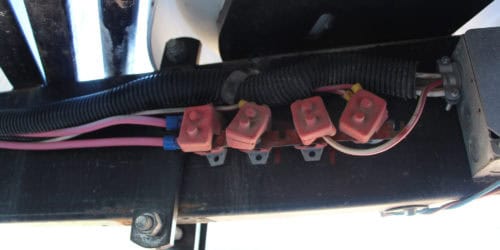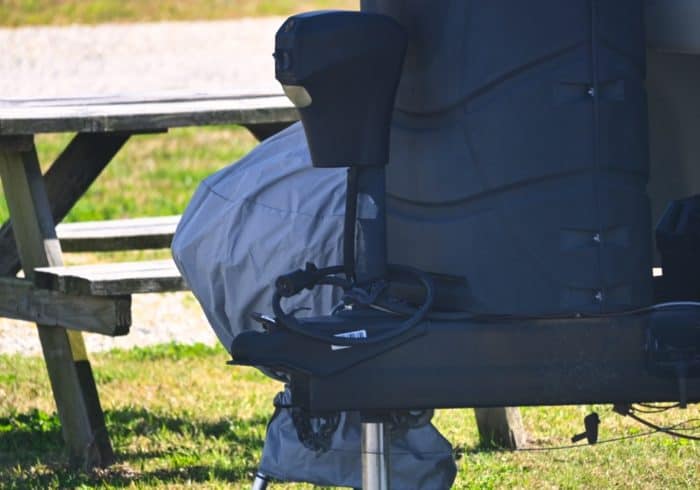Why Install An Electric Tongue Jack On Your Camper/Trailer?
Electric trailer tongue jacks are really easy to install and a huge upgrade from manual hand crank jacks.
They can save you a lot of work and most even come with LED lights installed to help you when hitching and unhitching at night.
If you live in your trailer full time or have a work trailer that you hitch and unhitch all the time, getting an electric jack is going to make life easier.
Related Product: Add snap on SnapPad Rubber RV Jack Feet (click to view on Amazon) to your RV stabilizers to add grip and eliminate the need for RV blocks.
How To Install An Electric Tongue Jack
Step 1: Buy the Correct Size of Power Jack
Installing a new power jack for your trailer should be a simple process if you have bought the right size.
The standard tube diameter for a-frame trailer jacks is 2.25 inches.
All the power jacks on my best electric tongue jacks for trailers have that diameter. If it’s a special size, you may need to order a custom electric jack.

You can buy power trailer jacks for tongue weights from 3,500 to 5,000 pounds, which means there’s an electric jack for almost any size and weight of a bumper pull trailer.
Safe tongue weights are up to 15% of your gross trailer weight (GTW).
That means even the lightest-duty power trailer jack (3,500lbs) can take GTW of up to 23,333 lbs.
My 31-foot travel trailer has a max GTW of 9,000, which means a 3,500 lbs electric tongue jack is more than enough.
To measure your trailer’s tongue weight so you know if you have it loaded down safely you can get a trailer tongue weight scale (click to view on Amazon) or use a do-it-yourself method using only a bathroom scale.
The DIY method only works on a lighter trailer. If you have a heavy-duty work trailer, you will have to buy a scale.
Step 2: Take Weight Off Of The Trailer Tongue Jack
The next thing you need to do before you unbolt things is to get the weight off of the front jack of the trailer. Do not use the front stabilizer jacks to do this.
The easiest way is to hitch it up to your tow vehicle. That way, the weight is off and your trailer is secure.
See Also: Best RV Wheel Chocks (Plastic, Rubber, Metal, X-Chock)
Another option is to put the weight of the trailer onto some heavy duty jack stands (click to view on Amazon).
Make sure you are using wheel chocks so your trailer won’t roll while you’re working on it.
Step 3: Remove The Old Tongue Jack
Removing a manual tongue jack on an a-frame trailer should be easy. Just remove the 3 bolts on the mounting plate of the jack.
If the bolts have rusted, you may need to spray them with a rust penetrant (click to view on Amazon) first to help loosen them.

Step 4: Bolt In The New Electric Jack
Once the old jack is removed, just line up the new electric jack’s mounting plate with holes already in your trailer’s A-frame.
Make sure the power jack’s electrical housing is facing forward or to the side if the option is available.
See Also: Best RV Stabilizers For RV, 5th-Wheel & Travel Trailer
The reason you should turn the head so it faces sideways is to make room for the tailgate of your truck.
Certain travel trailers and truck models have less space on the hitch or taller tailgates, which means the top of the electrical tongue jack can sometimes get in the way.
Step 5: Electrical
If your trailer jack is powered by a 7-way plug, you are now done with the installation process.
If your electric trailer jack just has two open wires, you will need to crimp on a battery eyelet terminal.
The wire is normally 10-12 gauge and the eyelet should have a 5/16 stud hole.
Because these connectors can be out in the elements, getting an eyelet terminal with heat shrink as well is a good idea.
A pack like this one (click to view on Amazon) will have everything you need to make a good connection for your electric jack.
Once you’ve installed the eyelets, you can either connect your electrical tongue jack directly to your battery or you can connect it to the electrical junction usually located under the tongue of the trailer.
It should look like this.
See Also: Best Weight Distribution Hitches With Sway Control

To connect, just lift one of the red rubber protectors and bolt in your cables. Make sure you connect the right wires to the right spot.
Grounding wire to grounding wire, hot wire to hot wire.
Electric Tongue Jacks with Only One Wire
Some companies are releasing electric tongue jacks that only have one wire. Like this one by Lippert (click to view on Amazon).
The single wire is the positive or hot wire and you’ll connect it to the positive terminal post on your travel trailer’s frame.
The grounding is done through the mounting hardware so there’s no need for negative wires.
It means you can’t test the jack before installation because it needs to be mounted in order to ground.
Also, make sure the mounting holes on the frame of the trailer are clean and rust free so the jack’s bolts can make a good connection for grounding.

Why Not Connect My Electric Tongue Jack Directly To The Battery?
One way to make the wiring process much simpler, especially if you are replacing a manual tongue jack with an electric one, would be to wire it directly to the trailer battery.
That method works fine and you can go that route if you want, but there are a few scenarios where it’s better to wire it to the junction on the frame.
If you have it wired to the battery and the battery dies, you won’t be able to use the electrical jack and you will have to find the manual crank, or plug in your trailer and wait until the battery is charged enough to power the tongue jack.
If you wire it to the electrical junction, the jack will use power from the RV converter when you are plugged into shore power.
It will also be able to draw power from your tow vehicle, which means you could use it even if there isn’t a battery connected.
The final reason to not wire it directly to the battery is to help reduce the load on it, which will keep it healthy longer.
See Also: How To Wire Multiple 12V Or 6V Batteries To An RV
Once you’ve got it connected, you should be able to turn on the power using a switch located on the jack.
If you can move the jack’s foot up and down using the up/down switch, you are good to go.
Have questions about installing an electric trailer jack? Leave a comment below.


Not to be a crazy person, but shouldn’t you hook the trailer up to the truck before you remove the jack???? It was never mentioned in your description!! Or were we just supposed to assume that??
Hey Tom,
You’re so right, I suppose I meant it to be implied but I see now it should be added to the steps for clarification. Thanks for the input.
Well said.
The old jack has two wires the new one only has one wire
Hi Charles,
Newer electric tongue jacks are starting to use just one wire. That wire is the hot wire and the tongue jack will ground via the mounting hardware.
I want electric jack for my cargo trailer. Is there an adapter to plug into the vehicle power plug?
Hi Dennis,
There are electric tongue jacks that come with 7 way plugs like this one by Uriah Products (click to view on Amazon). These won’t work with the smaller 4 way plugs if that’s what your vehicle has.
Another option would be to put a 12 volt battery on your cargo trailer and wire any regular electric tongue jack directly to that battery. You can see more electric jack options in this review here.